Are you currently an author or want to write a book? Please send me a connection request on LinkedIn: Jonathan Goodman
–
Before we begin, a big thank you to Nir Eyal , Simone Stolzoff , Alex Wieckowski 📚 , and Ed Latimore for their excellent feedback on early versions of this article. If something is clear and helpful, credit them. If not, blame me.
–
Seth Godin said that an author’s job is to sell the first 10,000 copies of their book. It’s the book’s job to sell the next million.
Unhinged Habits comes out in six months. This is my marketing plan to get those first 10,000 readers.
Whether you're planning your own book launch, curious about modern marketing tactics, or interested in how ideas spread in our insane world, this’ll help.
It includes:
Optimizing book content for virality.
Exploiting underpriced marketing opportunities.
Getting book sales post-launch.
I’ll begin with a short recap from my last book launch. Then, to help orient you, I’ve split each component of the marketing plan into three sections:
Pre-launch
Deciding not to do podcasts
Editing the book for social media
Getting blurbs
Building a media kit
Selling preorder copies via pop-up coaching groups
Growing the email list
Launch
Trading creator newsletter placements
Getting recommended in micro-newsletters (at scale)
Sending influencer copies
Building a Book launch team
Oprah?
National newspapers and guest articles
Solving the non-existent present problem
Post-launch
Seeding copies to ideal readers
Habitpalooza!
Bundling books with other authors
Each component will list dates, why I’m doing it, how I’ll make it happen, and what could go wrong.
This is a lot. Consider it a resource to revisit, not a one-time read. I dunno, maybe print it out.
Also, it’s a diary, not a report.
I’ve read a lot of books and articles about book marketing. But they were all written after the book got published.
I always wished I knew what the author was thinking when they made the plan.
Like, why did they choose that thing they did that didn’t work. In hindsight, it was a dumb move. But there had to be a reason.
History books are retrospectives. The authors telling the story already know the ending.
Diaries are more interesting than history books. A diary is written in the moment. The person doesn’t know how the dust is going to settle. You get their emotion and reasoning based off of the limited information that they have when they’re writing it.
My book hasn’t been released yet. This is the diary of its launch, not a report on what happened.
–
I have one ask of you:
I’ve put 30 hours into this. It’s yours for free. All I ask is that you please comment the words “super helpful” to juice the algorithm and help others discover it.
Why my last book launch bombed
My last book, The Obvious Choice, was released on January 14th, 2025 by HarperCollins. The launch bombed.
I did everything you’re supposed to do . . . Built an audience. Got a six-figure deal. Wrote a great book. But I made a few pivotal marketing mistakes, which became obvious in retrospect.
I’ve been an online marketing guy for 15 years, generating over $40 million from 200,000 customers. That includes selling 105,000 copies of a self-published a book.
I've had successful launches before. Bombing felt awful. I'm determined not to repeat it.
Before I began making a marketing plan for my next book, I did a post-mortem of the last launch: what was good, what was bad, and what was dumb luck.
What went well
Book launch team. There were over 300 in it and all had preordered two books.
Hyper focus on a hyper-connected micro-community. At the intersection of people who talk about stuff they like, who my book can help, and who I am was the CrossFit community.
I’ll be doing a book launch team again, but hiring somebody else to operate it this time. And I’m double-tapping on micro-communities, focusing on both gym owners and other authors this time around.
What went badly
Podcasts. I appeared on 75 podcasts. It was a giant waste of time.
Lack of collaboration. I focused too inward on my own thing, and regret doing so much self-serving content and so little collaboration with other authors and experts.
Built a low-quality audience. Too much emphasis on superficial metrics like engagement and too little on depth.
Zero consideration for post-launch.
This time around I’m not doing podcasts. I am collaborating a lot with other authors, and I will be focused on building quality connections, one person at a time, algorithms be damned.
Where I got lucky
Viral content. A few illustrations went viral, earning me millions of free impressions for the book.
Social media sharing of book content is too valuable to leave to luck. I hired an expert and did a full-on social media edit of Unhinged Habits. More on that soon.
–
Let’s dig in. Here’s everything that I’m doing behind my book to make it a success:
1. (Pre-launch) Deciding not to do podcasts
Sahil Bloom identified fairly-priced and underpriced opportunities when launching his instant NYT bestseller, The 5 Types of Wealth.
Fairly-priced: Everybody knows you should do them and so their value is decreased.
Underpriced: What most people don’t know about but are highly impactful.
I'm a father to three young kids, own two businesses, and need to work out. With limited time, I can only pursue underpriced opportunities where I have a competitive edge.
Constraints, while frustrating, force clarity. It's easy to scatter your efforts across multiple good marketing ideas and benefit little. Books are like rocket ships—they need gigantic, focused effort to reach escape velocity and enter orbit.
Most good books never reach that escape velocity because authors spread themselves too thin across too many tactics. It's better to identify the best opportunity for you and go all in than to try everything because some course creator says you should.
When planning my book launch, step one was to figure out what not to do.
To help find what that was, I built a three-part framework:
It had to be currently underpriced.
I can’t have any major constraints stopping me.
I must have either unique connections or leverage.
My goal was to find opportunities in the sweet spot and execute on them at level 100.
Based off of this, I came to two conclusions:
I am not doing Podcasts:
Here’s a hot take: podcasting is terrible for book marketing.
The top 25 U.S. shows earn about half of all listening time. The vast majority of podcasts have tiny, fragmented audiences that don't sell books. The power-law nature of podcast audiences is undeniable and opportunity cost for those who obsess over them is absurd.
For my last book launch, I appeared on 75 podcasts. Outreach, scheduling, prep, travel, and guesting ate up over 200 hours of time without any noticeable bump in sales. I wasn't booking major shows, but that's exactly the problem: the podcasts most authors can actually get on don't have audiences large enough to matter.
Podcasting to sell books is backwards. It's something you do once your book is already popular, not how you make it popular in the first place. At best, it's an inefficient way to sell books and, in most cases, a complete waste of time and energy.
For me specifically, the constraints make it even worse. I'll be living in Indonesia when my book comes out—a time zone nightmare for recording, not to mention the whole busy father thing. I have no unique connections or leverage like a popular podcast of my own. I haven't invested in the media training necessary to show up as a polished, compelling guest who moves the sales needle. And I don't want to. I'd rather invest that time becoming a better writer.
Everybody says you should do podcasts, which is exactly why their value has decreased. They're currently fairly-priced, not underpriced. Which makes it a good tactic, but not a great tactic to employ––the most dangerous kind of tactic.
2. I am doubling down on newsletters:
Newsletters are underpriced. The writer has earned trust and the conversion process of a straight link to Amazon to buy a book is low friction.
Time zones don’t have to line up in order for me to get recommended in a newsletter. There’s also not a lot of net new effort on my end to do a lot of them. Living in Indonesia around the time of launch and having three young kids isn’t a constraint.
I have leverage. My newsletter of 70,000 makes it easy to propose trading placements with others.
–
As you read through this book marketing plan, you’ll notice that everything I’m doing was chosen because I believe it’s underpriced and I come into it with some sort of leverage.
2. (Pre-Launch) Editing the book for social media virality
Your book is the marketing. Optimize its content for social sharing. The four areas to look at are the table of contents, illustrations, pull quotes, and portable stories.
A bit more on each.
Optimizing your table of contents
Your TOC is a sales letter. The chapter titles are bullets. I had placeholder chapter titles. Once the book was done, I used Claude.ai to dial them in.
Here’s the prompt that I used:
I'm writing a self-help book. The goal is to turn it into a NYT bestseller and a perennial bestseller. Below are the chapter titles. I would like you to give them a ranking based on the “Flip test”: Would you turn to that chapter? Your ranking can be letter grades like a test in school A, B, C, D, and F.
I then rewrote anything that didn’t get an A until it did. Here’s the final table of contents for Unhinged Habits:
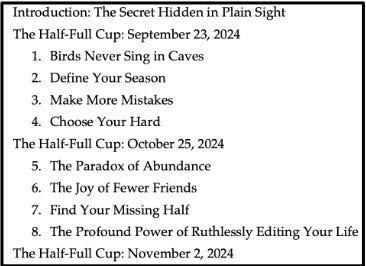
Earning millions of free impressions with viral illustrations
This illustration is from my previous book The Obvious Choice. It was shared by a book influencer and got 367k views.
Other accounts noticed its performance and shared it. In total, this one image has generated millions of free impressions for my book.
The problem?
The pic doesn’t include the name of my book . . .
–
Books are discovered on social media.
Books don’t get shared on social media because they are good books.
Books get shared on social media if they earn clout for the person sharing.
Once content from a book goes viral on social media, other accounts pile-on and copy it.
A single illustration or pull quote has the potential to generate millions of free impressions for your book––more than any other marketing tactic
The greatest underpriced marketing opportunity right now is viral book content.
Having that image go viral from my last book was lucky. I do think I can manufacture luck this time around. Not many authors think about viral illustrations when they produce books, which makes for an asymmetric opportunity for those that do.
Before my final round of edits, I hired one of the top book influencers in the world, Alex Wieckowski 📚 , to do a social media edit of Unhinged Habits.
Here’s a few changes that we made:
Added more images: Each additional one increases surface area for luck. But too many hurts the reader flow. I settled on 27, or one for every 2,000 or so words.
Simplified the design: Kept words to a minimum and opted for a clean, modern, and minimalistic design.
Added a title: Think of every illustration as a mini-sales asset for your book. Eyes will go to the image → Title → Back to image → Caption.
Write a compelling caption that stands on its own: Imagine as if you're a world class ghostwriter for X when writing the captions. Assume that the image does not appear next to the caption and that the viewer has not read your book. It acts as a mini-sample of your book’s content in the feed.
Add your book title: Make sure it’s visible if/when the illustration is shared.
An example illustration from Unhinged Habits:
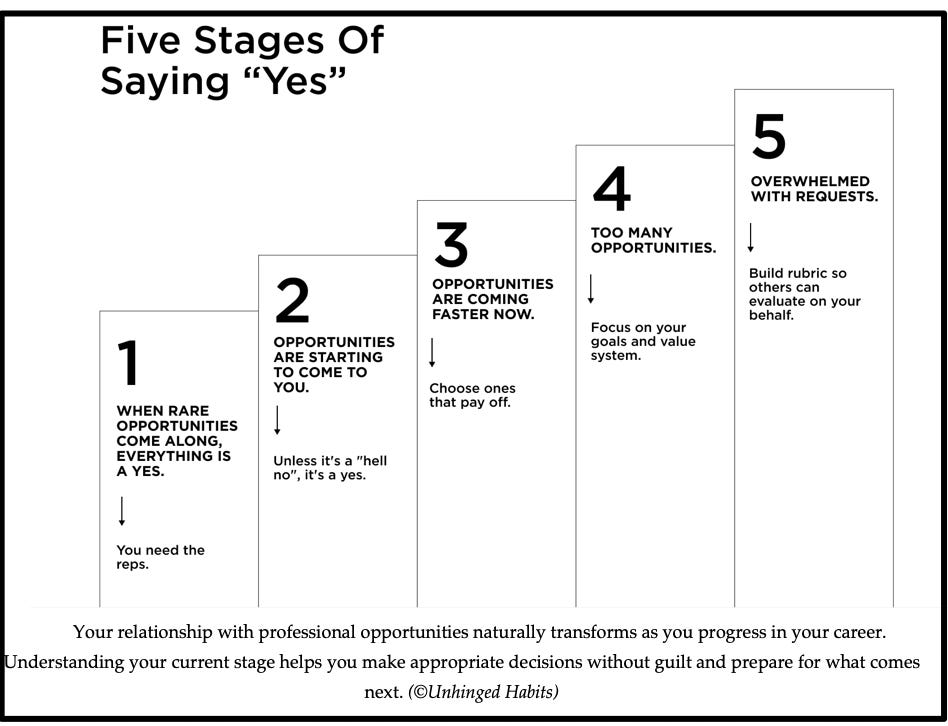
Formatting pull quotes
Now something I’ve never heard before.
Alex told me that he found a section for a post he was sure would go viral in The Obvious Choice but he couldn’t share it.
Why?
Because of the interior layout.
Yeah, seriously.
The lines he wanted to share spread across two pages. He can’t take a picture of two pages for social media. It wouldn’t perform well. So he didn’t share it. This is the world that we live in. Get in front of the problem.
My editor, Alex, and I all went through the manuscript and highlighted the most compelling aphorisms and tidbits. We’ve highlighted them for the interior designer with instructions to ensure they don’t spread across two pages. If they do, we’ll move some text around.
Turning your ideas into portable stories
People don’t remember books, they remember stories. Take your best ideas and turn them into memorable metaphors you can easily talk about in videos and in content.
An example:
I’ve got a chapter on adult friendship. It stresses the importance of categorizing your friends loosely based on a modernized version of Aristotle’s Ladder. A strong but not-memorable idea that evolved into The Garden of Friendship.
Talking about it as a metaphor is easy on video and straightforward as practical exercises in the book.
Plus, connecting it to a garden triggers recall. When my reader is in a garden, they might remember and retell the story. “Being in the garden reminds of a great take on adult friendship I just read . . . “ Boom, word of mouth.
–
The remainder of this marketing plan is tactical. I’ll follow the same format for each tactic moving forward.
3. (Pre-launch) Getting blurbs
What is it?
Blurbs are short and catchy promotional lines for books, written by well-known people. You see them on the back of hardcovers and Amazon pages.
The best blurb to get is from a big-name author in your genre.
Why am I doing it?
Blurbs won’t get my book discovered but they could get my book bought after it’s been discovered.
What assets are required?
Pure hustle, bro.
Important dates:
July 31 (8 mo before launch) - Deadline for blurbs.
Early May (10 mo before launch) - Began asking.
Mid July (8.5 mo before launch) - Followed up.
How am I making it happen?
Blurbs are usually more of a character reference than a comment on the quality of your book. This is a long-term relationship game.
To get mine, I focused on 3-5 key people. Called it my ‘wildest dreams’ list. Became their biggest fan. Bought their stuff. Joined their newsletter. Responded to their emails. Attended their events.
Of the five, I earned the trust of one of them. He told me he’d love to support my book. I asked for a blurb.
What could go wrong?
-Putting it off for too long because I’m nervous about it.
-Somebody saying yes and then not following through (when do I follow up, and how?)
The whole book blurb thing is super weird, actually. It’s a part of the process that I dread. Asking for them makes my armpits sweat.
–
(I’ve written a post with more detail on what blurbs should say, how to get them, and tricks of the trade I wish I knew earlier to make them more beneficial. Click here to read it.)
4. (Pre-launch) Building a media kit
Much of this section is from an episode of the ‘Don’t Write that Book’ podcast called Marketing Assets You Need. Thank you to Anjanette “AJ” Harper and Mike Michalowicz for their excellent pod.
–
What is it?
A page on your website for influencers, reporters, and podcasters to easily grab info about your book that they may need.
Why am I doing it?
The easier you can make it for somebody to talk about your book, the better a chance that they’ll do it.
I hate doing stuff multiple times. This way I create all key assets to support my book once for reporters, podcasters, creators, and my own use.
What assets are required?
The media kit includes your book’s info, a bio, headshot(s), pics of the book, graphics with pull-quotes, endorsement graphics, and a pdf summary of the book.
(For reference, here’s the media page for The Obvious Choice)
Important dates:
Week of Jan 5 (3 wk from launch) - Create all assets
How am I making it happen?
I already have the list of what I want to include. I’ll put my manuscript into ChatGPT and ask it to create the first draft of each asset. Then I’ll edit it.
Is anybody else involved?
I hired a photographer named John A. DeMato to do a book photoshoot for The Obvious Choice. He calls it Book Boudoir. Which is hilarious. My publisher shipped him ten copies and he took the pics.
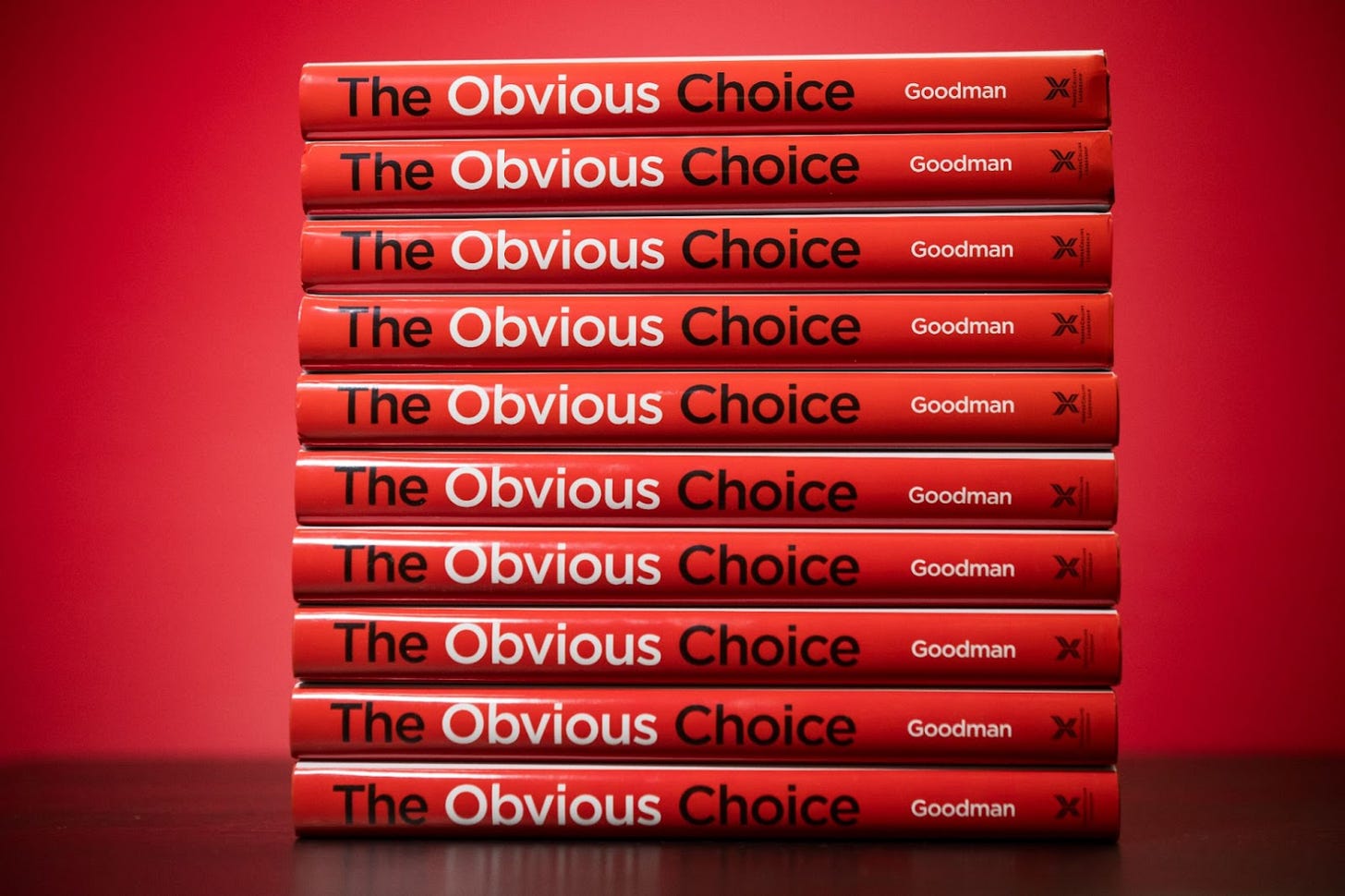
I’ll use a graphic designer on UpWork to get the endorsement and pull-quote images made.
What could go wrong?
Hmm, nothing really. Other than forgetting to do it, I guess. It’s on my calendar for January.
5. (Pre-launch) Selling preorder copies via pop-up coaching groups
What is it?
Two three-week long paid coaching groups. One topic a week for three weeks. Each will include a pop-up community and a presentation.
One for gym owners (topics like turning client results into business growth) and one for authors (topics like how to create viral social media content from your book).
Members of both groups will receive five copies of Unhinged Habits on launch day.
An important nuance:
I’m not inviting people to join if they preorder five copies of the book. I’m selling a pop-up coaching group and the book is positioned as a bonus.
Nobody’s read my next book yet. Preorders are a hard sell. Coaching’s an easier sell because I can communicate the benefits and outcome of it easier.
Why am I doing it?
I have a few goals with preorders:
Sell them (obv.)
Create a concentration of buyers in a few industries.
Get more than one copy in a person’s hands so that they give my book to a friend or colleague.
Hosting a targeted coaching group is something I can do well in advance of my book launch. I have unique connections in both the gym owner and author communities to sell this and make it valuable.
During launch week, my book will be delivered to all attendees at the same time. Because they are all in the same two industries, it will create a concentration of buyers all sharing that they received the book in the same micro-communities, creating the illusion of omnipresence within that world.
What assets are required?
Promotional emails, a landing page, and social media stuff for selling the group. Partners on board (already done). Presentations.
Important dates:
Week of Sep 8 (4.5 mo from launch) - Prep all promotional material.
Week of Sep 22 (4 mo from launch) - Marketing / Promotion.
Sep 29 - Oct 18 (3 mo from launch) - Run the group.
How am I making it happen?
I’ll sell it as a regular product. The money I take in will be used to preorder copies of my book to send to participants.
Book stores offer bulk order pricing. There are some (Porchlight and Givingtons) that will also do fulfillment. I’ll provide them with a .csv of all names and addresses and order five books per person. They will fulfill the books for me to arrive on launch day. In addition, because they are considered a local book store, all sales will count towards the bestseller lists.
Is anybody else involved?
I have three presentation partners total and will utilize a VA for things like image creation, exporting, and cleaning the mailing list. Other than that, just the bookstores, which is as simple as email outreach.
How I’m finding people to sell these coaching groups to
My social media is segmented into two personas:
On Instagram, I’m the “let’s make fitness human again” guy for personal trainers. (Follow me here)
On LinkedIn, I’m the author and book guy. (Send me a connection request here.)
I already have a segmented email list with 3,000 gym owners. I’ll also ask a few friends who sell services to gym owners to ‘sponsor’ the coaching group by emailing their community about it in exchange for them being listed as a sponsor. I’ll also promote it on Instagram.
For authors, I’m building an audience through this newsletter. My co-presenters have audiences and reputations in that world.
In both cases, I’ll do a combination of email blasts, social media, and one-off messaging. Figure I’ll probably send 1,000 manual messages.
What could go wrong?
-Scattered attention makes dedicated bursts of marketing to audience segments hard. I do think that I have enough people in both markets who know, like, and trust me but getting their attention during such a short promotion window could prove challenging.
-This is a new coaching group. There’s no existing brand or reputation. And it’s only happening once. That’s a marketing angle for sure. But I’m worried that answering the “what is this and why do I care” to busy people will get ignored. Then people will miss it, and it’ll be too late for both of us.
-Whenever I work with partners I’m worried that they won’t deliver, follow through, or even show up.
6. (Pre-launch) Growing the email list
What is it?
Increasing subs.
I write a weekly newsletter with 70,000 subscribers called 5-Reps Friday and started this pop-up newsletter.
Leading into January, I’ll be manually inviting people to join the email lists in addition to promoting high-value pieces of content in exchange for an email across my social media.
Why am I doing it?
I’ve been an internet marketing guy since 2011. Gone through countless algorithms and social media changes. Email has been a remarkably consistent way to build trust and sell online.
What assets are required?
Landing page at www.5repsfriday.com.
Individual landing pages, forms, email sequences, and ManyChat automations for promoting high-value content (like the article about my last book launch bombing).
Important dates:
Ongoing until launch.
How am I making it happen?
I get new followers and connections across social media every day.
Myself, or a VA, will message every one manually, say hello, and invite them to subscribe to my newsletter. If there is extra capacity one day, we will go through existing followers and message them, beginning with the most recent.
You can’t get 10,000 new subscribers without getting 10. One by one we go, rep by rep.
The other more scalable method I do to build my list is to build an opt-in page for a high-value piece of content. I’ll then create Instagram stories promoting it and use a ManyChat automation to deliver the link to the page where the person can enter their email.
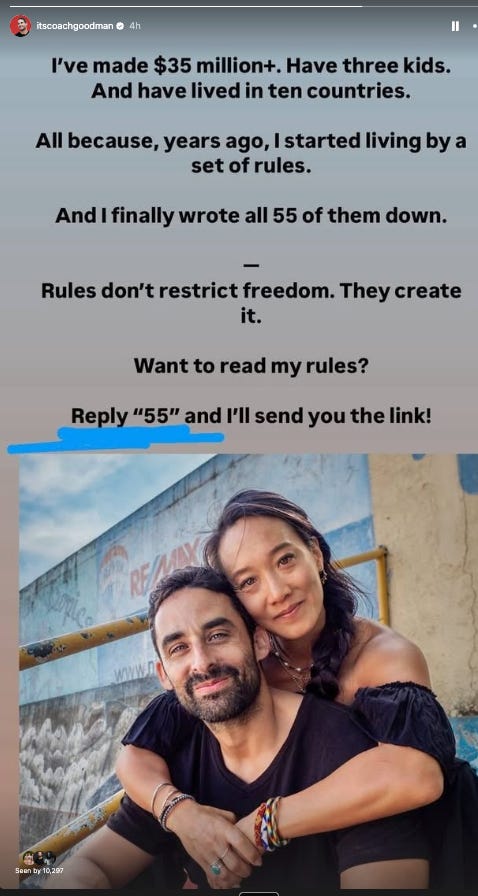
Our team follows up via DM and books sales calls for my mentorship with qualified prospects. Then we send paid traffic to the best performing ones. Chenell Basilio did a great writeup on my flywheel content-to-coaching list-building system here.
This method gets more subscribers but they are lower quality because they came in primarily for the giveaway.
(Check out an example of an opt-in page with my 55 rules for freedom here or the one about my previous book launch bombing here. I create content that sends people to it across social media, but mainly my Instagram because it is my most followed account.)
Is anybody else involved?
A virtual assistant will be in charge of sending the initial outreach message. I will then follow up to all responses personally.
What could go wrong?
-Not enough quality. It’s easy to grow an email list with things like free giveaways (especially when supplemented with paid traffic). However, when somebody’s only on your list because they wanted a free thing, they’re lower quality.
7. (Launch) Trading creator newsletter placements
What is it?
I’m promoting two people in my 5-Reps Friday email newsletter every week. In exchange, I’m asking them to promote Unhinged Habits the week of its release at the end of January.
My goal is to have a minimum of 70 newsletters promoting my book the week of its launch, increasing impact with a big splash during launch week rather than small consistent drips.
Why am I doing it?
Leveraging other people’s email lists is an underpriced opportunity. Lists don’t have to be big to be meaningful because the creator has earned trust.
In addition, there’s not a lot of net new effort on my end. I can help others now by promoting them and collect all the owed debt at one time in a concentrated burst.
Anne-Laure Le Cunff, PhD told me it was the best performing promo she did for her book Tiny Experiments.
What assets are required?
Swipe material for others to talk about my book. This includes two sample emails, three different 2-3 line blurbs (one generic and one personal), and five images to choose from that I’ll provide the other newsletters to use. I’ll create a Google doc with it all.
Important dates:
Ongoing weekly (begin 6 mo from launch) - Outreach and promotion of others.
Week of Dec 15 (1.5 mo from launch) - Prep swipe materials. Prep email to promo partners.
Week of Jan 12 (2 wk from launch) - Contact promo partners. Send swipe materials.
How am I making it happen?
Outreach is via email or social media.
Tracking is done via Google Sheets.
They send me 2-4 lines for their promo. I save it into my calendar as an event on the day of their promo.
Is anybody else involved?
No, all me.
How I’m finding people to exchange with
Made a list of all I could think of.
I began adding people anytime I saw they had an email list.
Asked my audience.
Found other people who asked their audience to do something similar and added everybody who responded.
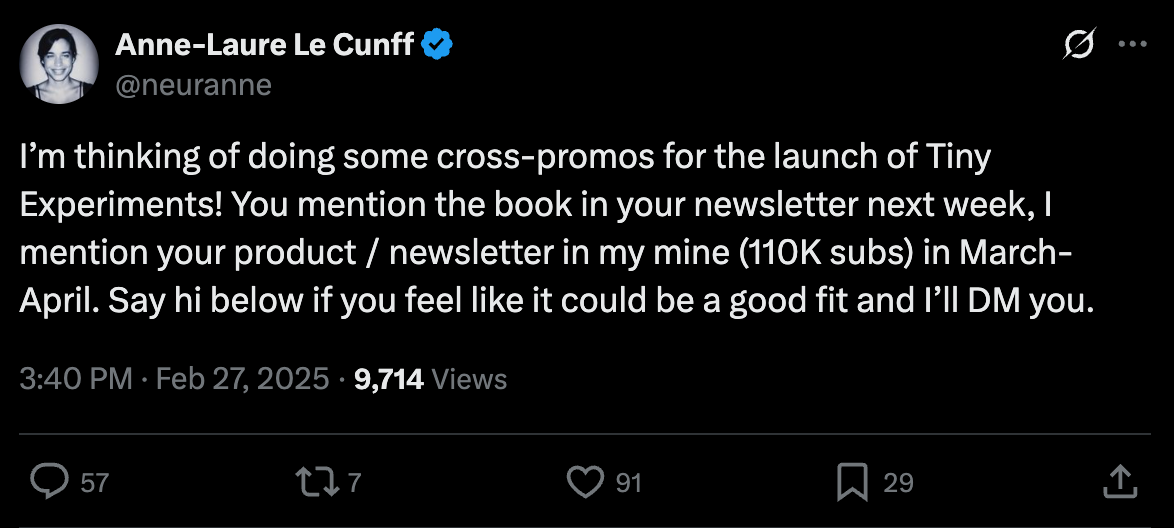
I also tried to go through Substack to find people who had lists but it made my brain hurt so I stopped.
Do you have a newsletter and want to do an exchange? You mention my next book in your newsletter the week of Jan 27th, I mention your product, book, or newsletter in mine (70K subs) sometime between now and Jan. We can align it around a launch you have if you like. Say hi in the comments or message me if you feel like it could be a good fit and let’s chat.
What could go wrong?
-I’ll put off inviting people to collaborate and it’ll get too late. I screw up stuff like this a lot––have a good idea but let it slide.
-Others I promote won’t hold up their end of the bargain.
-I make a deal with a bad actor. Promote them, and hurt the integrity of my reputation.
8. (Launch) Getting recommended in micro-newsletters (at scale)
What is it?
I want a minimum of 50 local gyms to email their members a recommendation to buy my book the week of January 27th.
Why am I doing it?
Local gyms have small and meaningful lists that are high-trust and have high open-rates. They’re always looking for content.
This seems like an extension on the creator newsletter underpriced opportunity that I have unique access to because of my reputation within the fitness industry.
What assets are required?
Outreach and promotional emails for the gym owners.
Important dates:
Week of Jan 5 (3 wk from launch) - Prep emails to gym owners + sample promo.
Jan 13 (2 wk from launch) - Email gym owners and offer them an early copy of my book.
Jan 23 (4 days from launch) - Follow up and ask the gym owner to email their members on launch day and provide them ready-to-go material.
How am I making it happen?
I’ll email my list asking people to respond if they own a gym and want a free book. I’ll share a similar message on social media and ask friends who sell things to gym owners to message their community on my behalf.
I’ll then offer to send an early reader (galley) copy to everybody who replies and ask that, if they like it, to email their community about the book during launch week.
Leading up to launch week, I’ll follow up again with prewritten material for them to send out.
Is anybody else involved?
Nope. This one’s all me.
How I’m finding people to exchange with
This one’s a unique asset I have because of my history in the industry. I’ll leverage my existing list, social media, and ask friends who run large coaching groups of gym owners to help me.
What could go wrong?
-Gym owners are often overbusy and underpaid. It could be hard to get their attention. or follow through on doing what they say they’re going to do.
9. (Launch) Sending influencer copies
What is it?
Sending 200-300 personally-inscribed early copies to colleagues and influencers. Each book will be signed, come in a custom mailer, and have page(s) tagged.
In the past, I’ve done incredible influencer boxes. This was for The Obvious Choice:
TBD whether I’ll go as big this time with the book packages.
Why am I doing it?
The hope is that receivers will share pics of the book, say nice things about it, and recommend it to their communities. In my experience, this doesn’t happen much. Everybody’s busy. My thing’s important to me. Their things are important to them.
Giving a book I worked hard on to people that I admire with a note thanking them for their impact on me is enough. I send these without any expectation of reciprocation.
What assets are required?
Design of the mailer, the physical books, and anything else I want to include in the package.
Important dates:
Influencer packages have a lot of moving pieces. I need my publisher to send me the books. Then I need to prep all of the packages. Then I need to send them out in a way that they’ll arrive the week of my launch. Dates below privy to change based on when the books actually arrive.
Dec 8 (1.5 mo before launch) - First outreach for addresses.
Dec 16 (1.3 mo before launch) - Follow-up with non-responders.
Jan 13 (2 wk before launch) - Send influencer copies.
Jan 23 (4 days before launch) - Follow up email checking if it arrived.
How am I making it happen?
Publishers will send out the books to influencers on my behalf but this is the type of thing where I want to do it on my kitchen table. The personal touch matters.
I’ll first message everybody who I want to send a book to. Once I have their permission and address, I’ll go through the list and identify what pages to tag for each depending on their interests.
I’ll then sign each book, tag the pages, compile the packages, and arrive to have them all shipped the week before my launch.
There’s one extra step I’m going to take this time around:
Using a post-it note, I’ll mark pages with potentially viral illustrations suited to their message. The easier I make it for them to get a viral post by sharing my book, the better chance they’ll do it as a win/win.
Is anybody else involved?
I’ll need somebody in the USA to ship the books on my behalf because I’ll be in Indonesia when they have to go out.
Not sure how I’ll facilitate this but, most likely, I’ll have all of the materials shipped to their address in the US and then fly there for a few days to sign and tag the books. Then I’ll leave the finished packages with them to ship out in accordance with my launch.
What could go wrong?
-I’ll be in Indonesia at the beginning of January for the start of a 6-8 month trip. My book comes out January 27th. Because I’m published by HarperCollins, I don’t know when I’ll receive the books.
-My publisher might not send me enough free influencer copies of the book. HarperCollins Leadership was great last time and happily sent me 300. However, I’ve heard other authors only get 50 and have to pay themselves for the remaining ones.
-My publisher might not pay the shipping. Again, HarperCollins was great last time and happily paid.
-So much can go wrong from not getting the books in time to the packages being screwed up and I’ll be on the other side of the world when it all goes down.
10. (Launch) Building a book launch team
What is it?
A group of people who preorder at least two copies of the book. I’ll give behind-the-scenes of what’s going on, buy people coffee, share previews of the book, and run giveaways.
Then, at launch, I’ll lean on them for support sharing the book writing Amazon reviews
For The Obvious Choice I had a book launch team of 300 people. They preordered 722 copies of the book. I would be looking to have 300-500 on the launch team this time around and sell just over 1,000 preorders.
Why am I doing it?
Book launches are a great time to bring a community together. It’s a place to share sneak peeks and do fun stuff like buy people coffee all around the world.
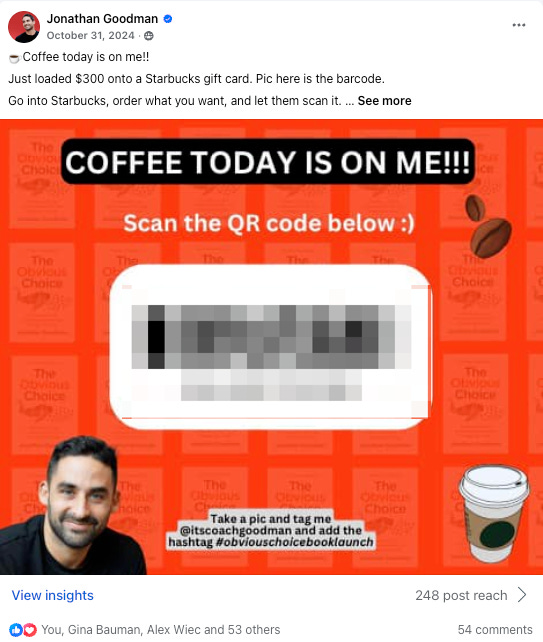
Of course, there’s added benefits as well. A book launch team is a way to get early buy-in of support, generate early reviews, and sell preorders.
For a book to be successfully long-term, it doesn’t just need to sell a lot of copies at launch. It needs to sell enough copies to different people. That’s an important nuance. Instead of trying to offer bundles where people buy 100, 500, 1,000+ copies at once (that will sit in a warehouse) in exchange for some prize or the promise of me flying to do a speaking gig, I did a thought experiment:
“What’s better for the long-term success of my book? Selling 1,500 copies to one person or 1,000 copies to 500 different people at launch?”
I decided that I’d prefer the latter option. I want my book read and passed on. Selling books that sit on a pallet in a warehouse somewhere doesn’t serve my long-term goals.
With this in mind, I structured the book launch team as a way to incentivize the people already most bought-in to my work (that would probably already preorder my book) to get two copies, not one so they gift it.
What assets are required?
Promotional emails and social media content that invite people to join. A group platform to host it.. A plan to operate the launch team. And a partner to operate the team itself, tagging me in where I can be of use.
Important dates:
Nov 26 - 29 (2 mo from launch) - Build promotional material
Dec 3 - 9 (1.5 mo from launch) - Marketing and intake
Dec 3––on (1.5 mo from launch) - Operating the team
TBH, I think that a month and a half is too long for a book launch team. Christmas and New Years are screwing me up here because I can’t do my intake over those weeks.
Because my book comes out January 27th, I have to either promote the launch team too early or too late. Normally I’d want to operate the book launch team for a month, not 1.5 months––enough time to go deep but not too long for momentum to fade.
How am I making it happen?
Across both email and social media, I’ll invite people to join.
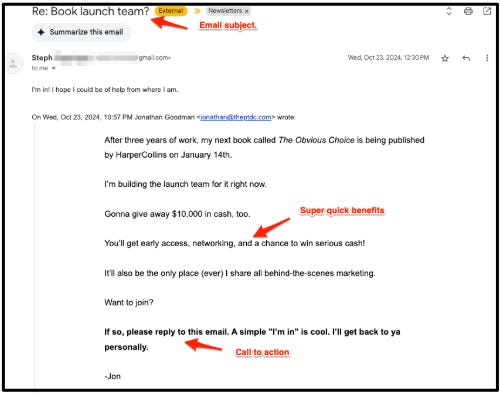
Once they reply, I respond with more details.
Unfortunately, I haven’t figured out a way to make the intake process less cumbersome. Which is a problem.
To join, they have to:
Preorder 2 copies of the books anywhere (in any format).
Submit the receipt to a form. The form also asks for their phone #.
After submitting, they got invited to join a Facebook group and added to a special email list.
Last time I had an upsell where they could preorder a third book and get a limited edition early reader (the galley).
HarperCollins agreed to ship galleys to anybody in the US, Canada, and the UK. 57% of eligible people on the launch team preordered three copies instead of two.
TBD whether I’ll offer this incentive again. It made an already complicated offer even more complicated.
Is anybody else involved?
Somebody else will operate the book launch group. I’ll be in it, but will need an operator. I know myself well enough to know that I’m happy to participate in stuff like this, but suck running it.
What could go wrong?
-I don’t follow-through. I had so many good things planned for my last book launch team and didn’t do most of them. We did everything we promised. Nobody on the team knew about the surprises that never happened. I mostly disappointed myself.
-It’s going to be a hustle getting people to join and will require a lot of manual messaging.
–
Launch teams are complex. I plan on doing a full article on mine soon. Please subscribe to this newsletter if you haven’t already so that you don’t miss it.
11. (Launch) Oprah?
What is it?
Send a copy to Oprah and Heather Reisman. Have them love the book and recommend it. Sell a gazillion copies. Become rich and famous and hire a private live-in foot masseuse.
Why am I doing it?
I dunno. Why not? I mean, may as well try.
What assets are required?
Customized influencer package of 5 copies of the book.
Important dates:
Dec 15 (2.5 mo from launch) - Prep influencer package.
Jan 29 (2 days after launch) - Send the packages.
How am I making it happen?
Found addresses for them already. Was easy.
Is anybody else involved?
I’ll be in Indonesia in January so I’ll have to find somebody locally to ship the book on my behalf. I’ll prep the package before I leave.
Hit me with it! Just give it to me straight!
What do you think the chances are of a guy like me getting promoted by a girl like Oprah?
Not good.
You mean, not good like one out of a hundred?
More like one in a million.
What could go wrong?
I get ignored. Which is likely.
12. (Launch) National newspapers and guest articles
What is it?
One placement at launch in a major National newspaper. The Globe and Mail, New York Times, or Wall Street Journal. I might also pitch the Canadian Jewish News.
In addition, I’ll do 50+ guest articles / op-eds in popular blogs and newsletters.
Why am I doing it?
Don’t think the newspaper feature will move a lot of copies but I do think it’s a great asset to share with my audience to help turn my book launch into what seems like a major event. Basically, a way to make my book launch look like a big deal to my community by getting major media attention.
The guest articles for newsletters is an extension of my focus on them.
What assets are required?
The names and emails of key editors / newsletter owners and pre-written articles in the style of the newsletter author.
Important dates:
Nov 24 (2 mo before launch) - Prep pitch.
Nov 27 (2 mo before launch) - Pitch first editor.
How am I making it happen?
This isn’t about PR or me or my book. I’ll pitch an interesting story to tell around my book.
I’m going to write the email in advance for each newsletter. Instead of asking if they’ll let me do it, I’ll just send it to them already finished in their style and formatting. The easier you make it for the other person to say yes, the better the likelihood they will.
I expect that some will ignore me. Most will say yes. And others won’t accept what I write, but will offer some promotion of the book because of my effort.
Is anybody else involved?
Had a long chat with Alex Hutchinson . He writes a column for the Globe and Mail and helped me narrow down my story into the kind of pitch editors are looking for.
Will also utilize a ghostwriter to help with the guest articles.
What could go wrong?
-My pitch gets ignored. (Probably in most cases)
-I pitch one editor and he doesn’t get back for a few weeks. In the interim, I pitch the same thing to another editor and then the first gets back and I have to renege my pitch.
13. (Launch) Solving the non-existent present problem
What is it?
A bundle promotion with another author to sell our books 2 for 1 as holiday gifts.
Why am I doing it?
Unhinged Habits comes out January 27th. I want people to buy it as a gift for Christmas or Channukkah.
But, if they do, there’s nothing to gift. Like, the book won’t come out for a month…
To (hopefully) overcome this, I’ll put together a bundle deal that has urgency where, for the price of one book, the person can buy two great books on habits.
When they buy, I’ll send them a .pdf to print that they can put in an envelope for the holidays.
What assets are required?
Promotional emails, social media assets, a new gmail account, and the flyer. This will be an internal promotion using existing platforms.
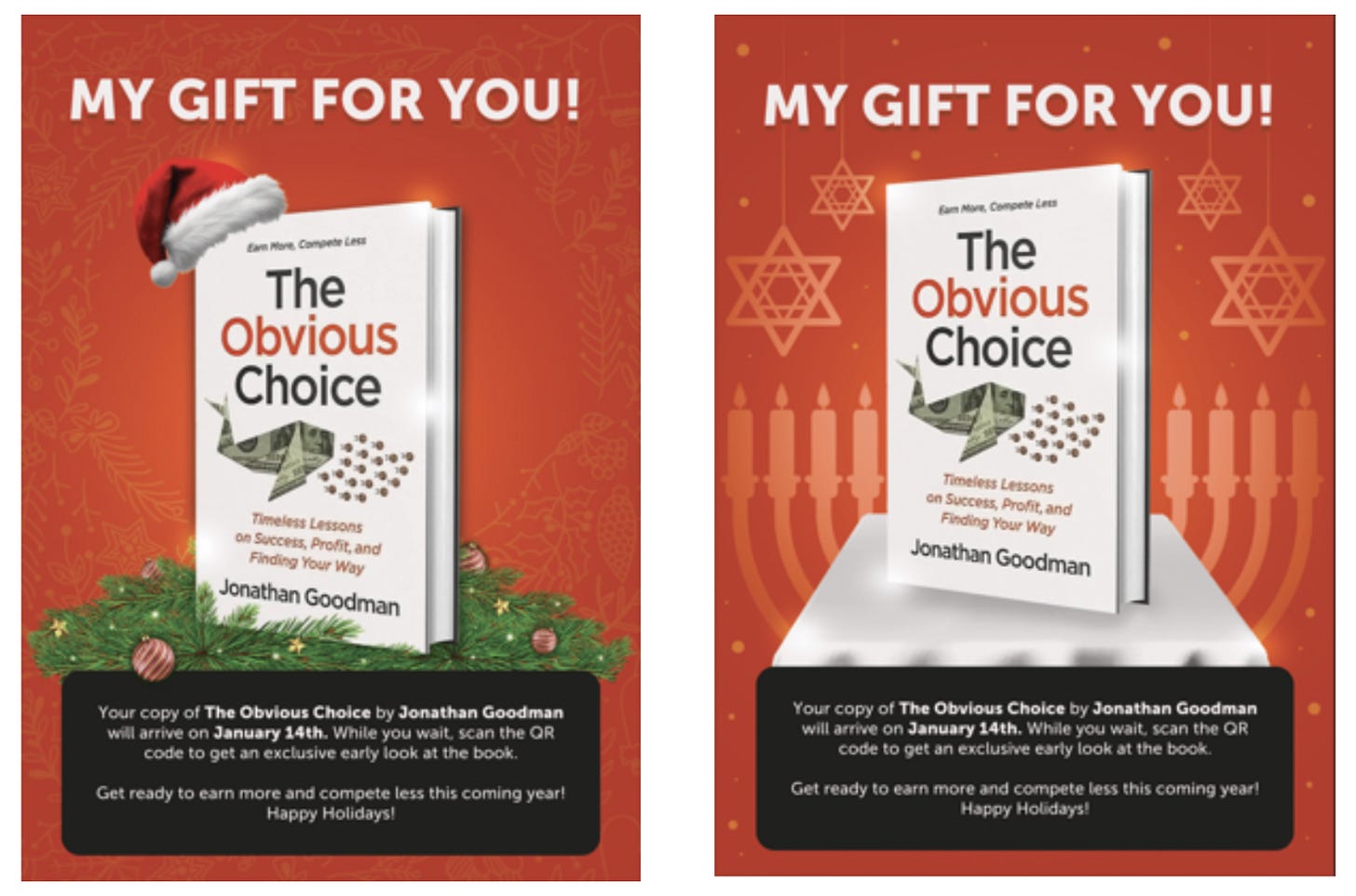
Important dates:
Sep 9 (4.5 mo from launch) - Prep all materials (far in advance just to get it out of the way)
Dec 16 - Dec 21 (1 mo from launch) - Run promo.
How am I making it happen?
I’m going to try and negotiate with a book store to offer my audience bundle pricing. Will ask them to set up a landing page offering both of the books so the buyer only has to buy once. Then I will set a deadline so this will be a time sensitive deal with urgency.
Once people buy, I’ll ask them to email their receipt to a new gmail account that I set up. This account’s out of office autoresponse will include the .pdf to print.
Is anybody else involved?
Another author, a bookstore, and a designer on UpWork to create the flyer.
What could go wrong?
-No book stores will guarantee a big enough bulk discount or make a unique landing page.
-The other author won’t follow-through and promote the deal to their community.
14. (Post-Launch) Seeding copies to ideal readers
What is it?
I’ll send 5 free copies to ideal readers every week after the launch. Not sure how long I’ll do this for. But a long time.
(Credit to Alex Strathdee for this idea in his excellent book Before the Bestseller)
Why am I doing it?
The more books I can get into the hands of my ideal readers, the better chance it will reach its tipping point. Once that happens, hooo boy, we in caviar and fuzzy slipper town baby.
These people don’t need to be influencers in the conventional sense. They need to be the right people for my book. Somebody who the book is going to come at the perfect time and who will recommend it locally.
Instead of hoping enough of the right type of people buy a copy, I’m going to find them and gift them. Before you get 10,000 readers, focus on getting 10.
Despite being traditionally published, the cost for me sending out books is relatively low. It’ll cost me about $100 a week to send 5 books. So long as every five books that I send result in an average of 25 copies sold I’m break-even.
I expect the result will be lumpy, with most gifted books not resulting in any sales and the occasional one resulting in a lot.
Tipping points aren’t evenly distributed events. Instead, as Malcolm Gladwell discovered, they’re the outsized results of actions of a few mavens.
With this in mind, if I discover one person that results in a lot of referred book sales, I’ll ship them more free books.
What assets are required?
S-H. Spreadsheet and hustle.
Important dates:
Nov 10 (2.5 mo from launch) Start building the seeding list.
Jan 7––on (Launch day) Begin outreach offering free books.
Note: I’ll be continuing to build-out the seeding list ongoing even as we begin sending out the books.
How am I making it happen?
I first mapped out my ideal reader avatar.
They're post-graduate professionals. Somebody who works a job held in high-esteem in their community. Teacher, accountant, doctor, lawyer, that kind of thing. 30-50 years old. Probably female, though that’s not 100% necessary. And has a side-gig passion project that they have at least one social media account about.
This isn’t the only type of person Unhinged Habits is for. It’s just who I think the book will come at the perfect time for, I can find them, there’s evidence that they like to share publicly about things that they like, and they’re respected in their community.
Going deeper, I decided that teachers with side-gig passion projects are going to be my primary seeding audience. They’re wonderful people. People in their community hold them in high-esteem. And their job is seasonal––which all lines up beautifully with my next book. Plus, teachers are the backbone of our society and we need to support them better.
Next, I found the perfect person who embodies all of this––Ms. Best (yes, her real name).
She’s my son’s old grade one teacher and has a side-hustle decorating cookies. I interviewed her, asking about her goals, frustrations, ambitions, and what social media accounts she follows.
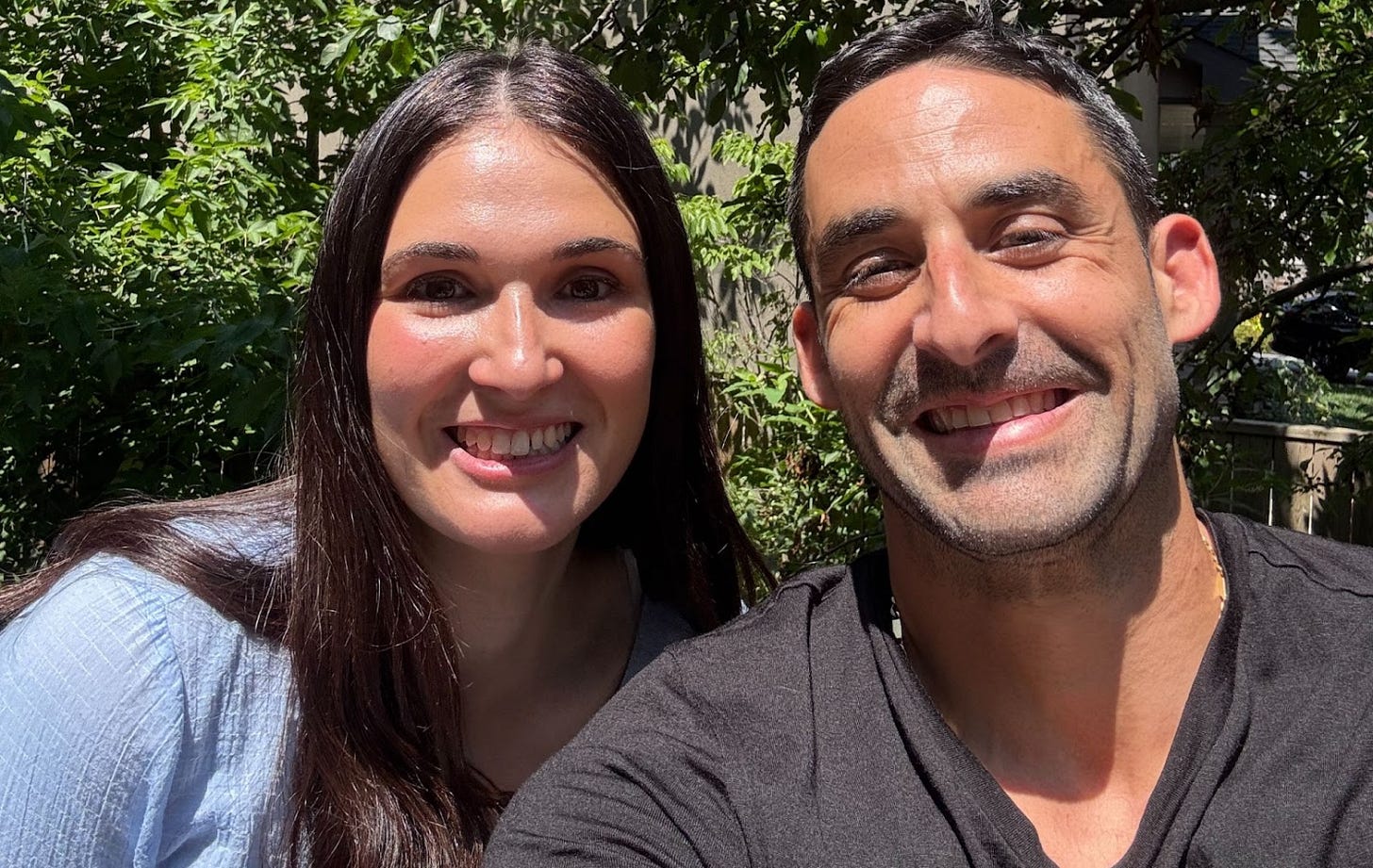
From that info I’ll write outreach language specific for people like her and use the accounts she likes as starting points because if Ms. Best follows an account, it’s likely many others like her also follow that account.
I’ll fill a spreadsheet with the names of 200-300 of my ideal readers on Instagram who meet my guidelines and then I will systematically reach out to 5-10 a week after launch, offering them a free copy.
When somebody accepts the copy, I’ll set a reminder to follow-up in three weeks to ask how they liked it and, if they did, ask that they write an Amazon review.
Is anybody else involved?
Might utilize a VA for parts of this.
I’ll need to arrange fulfillment of the books somewhere in the USA and have books and bubble mailers stored there.
What could go wrong?
-I’m bad at following through on things like this. This can’t be left up to me to do. If it is, I won’t follow through for long enough for it to be impactful.
-If shipping costs continue to rise, sending out books one-off could become cost-prohibitive.
15. (Post-Launch) Habitpalooza!
What is it?
A one-day summit co-presented by four authors who all write habits books that is going to happen in late March. I can’t say a lot about this yet or who is involved.
Why am I doing it?
Collaborating alongside other authors who write books to the same audience from a different angle is a way to pool our audiences, make some noise, get some excitement, and sell some dang books.
What assets are required?
Promotional emails and social media, landing page, and potentially paid ads.
Important dates:
Dates tbd. This’ll go down late March.
How am I making it happen?
I’ve been hosting author meals and meetups all spring and summer alongside Alex Wieckowski 📚 . Authors are eager to collaborate. You just need to take the initiative.
We’ll set up a landing page and sell tickets. The ticket will be to the event and, as a bonus, you’ll get a copy of each of our books for free. We’ll also offer upgraded tickets at higher price points. Not sure what perks we’ll add. But those will come with additional copies of the books.
After the event, we’ll do one bulk buy (at a discounted bulk rate) of all of our books through a bookstore and have the bookstore ship out the books to the attendees.
Is anybody else involved?
Three other authors. In addition, we’ll need a liaison at a bookstore and some admin and design help.
What could go wrong?
-My partners back-out.
-My partners don’t follow through on their promise of promotion.
16. (Post-Launch) Bundling books with other authors
What is it?
Limited time deal with another author who sells books to a similar audience at least two months after launch.
We will work with a bookstore to have a custom landing page made and sell our books together as a bundle. By leveraging our combined audiences, we will be able to get bulk order pricing and offer the books at 2 for 1 pricing.
Why am I doing it?
Some people will buy my book at launch. Most people will see the launch and think “that looks cool. I’ll buy that one day”.
In marketing, we have a nickname for what happens when people say one day: “Never”.
There’s gotta be a reason to buy now; some sort of urgency or scarcity.
Problem is that once a book is released, it sits there. There’s never any reason to act now. A limited time 2 for 1 bundle offer every so often should work.
We’ll also offer upgraded packages of multiple copies of the book. Not sure if there will be additional perks involved. Probably not. That seems like extra work I don’t want to do.
What assets are required?
A landing page that the book store will set up. In addition, we’ll need promotional emails and social media posts.
Important dates:
TBD. This’ll happen at the end of April. (At least two months after my book’s release.)
My hope is to do this 1-2 times a year.
How am I making it happen?
My guess is that a bookstore will set up a landing page and sell two books together as a bundle at a 50% discount so long as we can guarantee 200+ sales.
Is anybody else involved?
The other author and the bookstore.
What could go wrong?
-The book store won’t be willing to guarantee a discount for the books or create a custom landing page.
-The other author won’t do their part promoting the deal.
Will any of this actually work?
Man, I hope so.
Not all of it will though. And honestly, I don't know what will and what won’t.
But that’s what’s cool about publishing this plan in advance of executing it.
Whatever happens, it’ll be a fun and challenging ride and, if at the end so long as I can say that I’ve done everything that I could and left it all on the field, I’ll be happy.
Thanks for reading,
-Jon
P.S. Please send me a connection request on LinkedIn: Jonathan Goodman










Very helpful and generous to share
Super helpful. 🙂